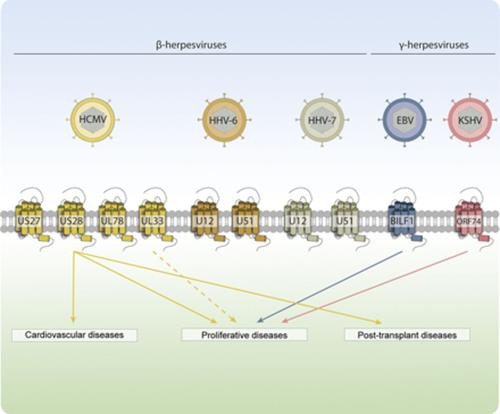当前位置:
X-MOL 学术
›
Pharmacol. Rev.
›
论文详情
Our official English website, www.x-mol.net, welcomes your
feedback! (Note: you will need to create a separate account there.)
Viral G Protein–Coupled Receptors: Attractive Targets for Herpesvirus-Associated Diseases
Pharmacological Reviews ( IF 19.3 ) Pub Date : 2021-04-01 , DOI: 10.1124/pharmrev.120.000186 Timo W M De Groof 1 , Elizabeth G Elder 1 , Marco Siderius 1 , Raimond Heukers 1 , John H Sinclair 1 , Martine J Smit 2
Pharmacological Reviews ( IF 19.3 ) Pub Date : 2021-04-01 , DOI: 10.1124/pharmrev.120.000186 Timo W M De Groof 1 , Elizabeth G Elder 1 , Marco Siderius 1 , Raimond Heukers 1 , John H Sinclair 1 , Martine J Smit 2
Affiliation

|
Herpesviruses are ubiquitous pathogens that establish lifelong, latent infections in their host. Spontaneous reactivation of herpesviruses is often asymptomatic or clinically manageable in healthy individuals, but reactivation events in immunocompromised or immunosuppressed individuals can lead to severe morbidity and mortality. Moreover, herpesvirus infections have been associated with multiple proliferative cardiovascular and post-transplant diseases. Herpesviruses encode viral G protein–coupled receptors (vGPCRs) that alter the host cell by hijacking cellular pathways and play important roles in the viral life cycle and these different disease settings. In this review, we discuss the pharmacological and signaling properties of these vGPCRs, their role in the viral life cycle, and their contribution in different diseases. Because of their prominent role, vGPCRs have emerged as promising drug targets, and the potential of vGPCR-targeting therapeutics is being explored. Overall, these vGPCRs can be considered as attractive targets moving forward in the development of antiviral, cancer, and/or cardiovascular disease treatments.
中文翻译:

病毒 G 蛋白偶联受体:疱疹病毒相关疾病的有吸引力的靶点
疱疹病毒是普遍存在的病原体,可在其宿主中建立终生的潜伏感染。疱疹病毒的自发再激活在健康个体中通常是无症状的或临床上可控制的,但免疫功能低下或免疫抑制个体的再激活事件可导致严重的发病率和死亡率。此外,疱疹病毒感染与多种增殖性心血管疾病和移植后疾病有关。疱疹病毒编码病毒 G 蛋白偶联受体 (vGPCR),其通过劫持细胞通路改变宿主细胞,并在病毒生命周期和这些不同的疾病环境中发挥重要作用。在这篇综述中,我们讨论了这些 vGPCR 的药理学和信号传导特性、它们在病毒生命周期中的作用以及它们在不同疾病中的贡献。由于其突出的作用,vGPCR 已成为有希望的药物靶点,并且正在探索 vGPCR 靶向疗法的潜力。总体而言,这些 vGPCR 可以被视为在抗病毒、癌症和/或心血管疾病治疗的发展中向前发展的有吸引力的目标。
更新日期:2021-03-11
中文翻译:

病毒 G 蛋白偶联受体:疱疹病毒相关疾病的有吸引力的靶点
疱疹病毒是普遍存在的病原体,可在其宿主中建立终生的潜伏感染。疱疹病毒的自发再激活在健康个体中通常是无症状的或临床上可控制的,但免疫功能低下或免疫抑制个体的再激活事件可导致严重的发病率和死亡率。此外,疱疹病毒感染与多种增殖性心血管疾病和移植后疾病有关。疱疹病毒编码病毒 G 蛋白偶联受体 (vGPCR),其通过劫持细胞通路改变宿主细胞,并在病毒生命周期和这些不同的疾病环境中发挥重要作用。在这篇综述中,我们讨论了这些 vGPCR 的药理学和信号传导特性、它们在病毒生命周期中的作用以及它们在不同疾病中的贡献。由于其突出的作用,vGPCR 已成为有希望的药物靶点,并且正在探索 vGPCR 靶向疗法的潜力。总体而言,这些 vGPCR 可以被视为在抗病毒、癌症和/或心血管疾病治疗的发展中向前发展的有吸引力的目标。











































 京公网安备 11010802027423号
京公网安备 11010802027423号